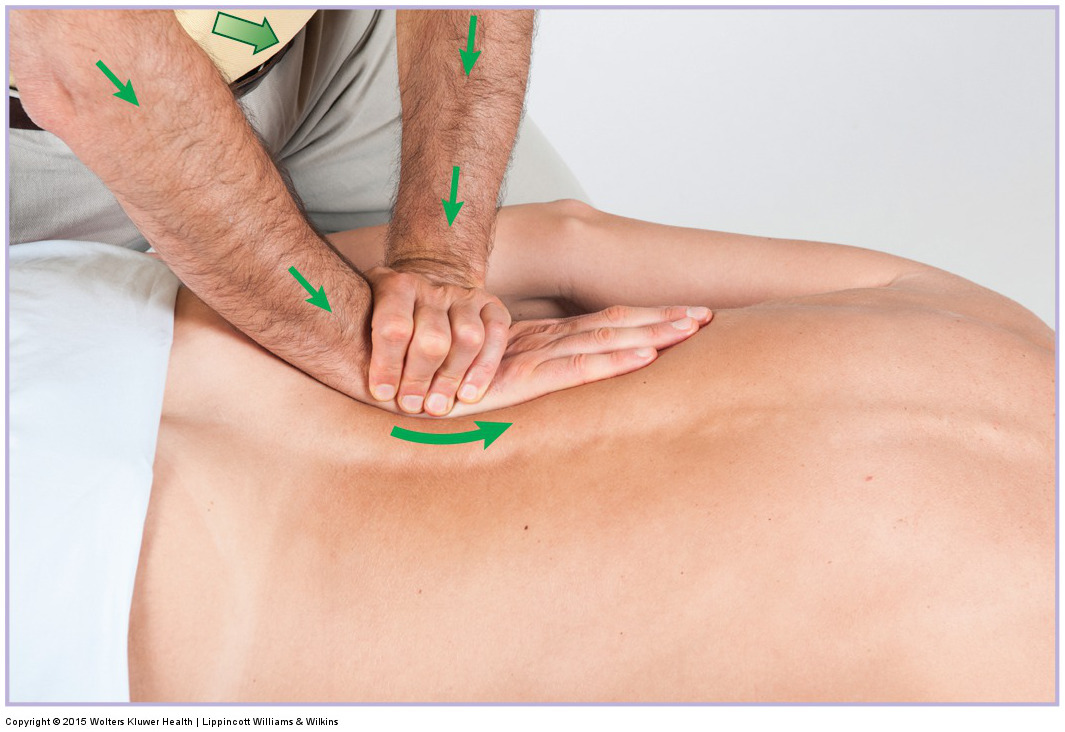Manual therapy treatment for a low back strain / sprain:
Manual therapy treatment for a low back strain or sprain is similar to the treatment of any muscular strain or ligamentous sprain.
Regarding a low back strain or sprain, because the musculature of the low back is so large and powerful, the first goal is to reduce the spasming. This is usually accomplished with soft tissue manipulation (massage) and heat followed by stretching. The exception would be that heat should not be used if the client/patient has appreciable swelling; swelling indicates ice as the appropriate treatment.

Long strokes to the paraspinal musculature with a braced flat palm contact. Permission: Joseph E. Muscolino. Manual Therapy for the Low Back and Pelvis – A Clinical Orthopedic Approach (2015).
Soft tissue manipulation to the low back for a low back strain and/or sprain should be directed first toward the paraspinal (erector spinae and transversospinalis) musculature with long strokes oriented from the lumbosacral level superiorly into the thoracic region. Work should always begin with light pressure, but should increase in depth as the patient’s/client’s tolerance allows. Be sure to access immediately lateral to the spinous processes into the multifidus/laminar groove musculature. If it is the sacroiliac joint that has been strained or sprained, then soft tissue manipulation should also be directed toward the gluteal muscles (especially the superior fibers of the gluteus maximus), piriformis, and coccygeus (and perhaps levator ani) if indicated.
If the client/patient has scar tissue adhesions from an old strain or sprain that was never treated and therefore did not heal well, then cross fiber friction strokes across the region of scar tissue is beneficial.
Manual therapy for a low back strain / sprain should include stretching the low back paraspinal; this can be done using double knee to chest stretch. Stretching the gluteal and piriformis muscles can be done with single leg to chest stretch for the gluteals and either Figure-4 stretch or horizontal adduction stretch for the piriformis. Once the muscle spasming has been reduced, joint mobilization should be performed for any lumbar or SIJ dysfunction that is present. If the client/patient experienced a sprain, then long term improvement dictates a self-care strengthening program to compensate for the injured and weakened ligament/fascial tissue.
Summary of Manual Treatment Protocol for Low Back Strain / Sprain
| 1. RICE if acute |
| 2. Massage to the paraspinal muscles, especially the multifidus/laminar groove musculature (for the lumbar spine) |
| 3. Massage to the gluteals, piriformis, and coccygeus if indicated (for the SIJ) |
| 4. Cross fiber friction for scar tissue from old strains/sprains |
| 5. Moist heat followed by double knee to chest stretching (for the lumbar spine) |
| 6. Moist heat followed by single knee to chest, Figure-4, and horizontal adduction stretching (for the SIJ) |
| 7. Joint mobilization as appropriate |
| 8. Strengthening self-care program for low back sprain |
Precautions/Contraindications:
When working on a client/patient who has a low back strain or sprain, make sure that the tissue has integrity, in other words the torn tissue has fully healed, before placing force into it for soft tissue manipulation or stretching. If performing deep work into the piriformis, exercise caution that excessive pressure is not exerted on the sciatic nerve. With knee to chest stretches and horizontal hip joint adduction stretch, if the client/patient feels a pinch at the anterior hip flexor region, place a towel along the inguinal ligament or add traction with you fingers to lessen the pinch. Avoid Nachlas test and the Figure-4 stretch if the client/patient has a bad knee joint.


